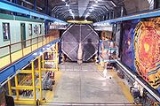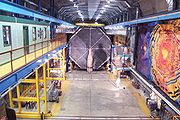
MINOS
Encyclopedia

Particle physics
Particle physics is a branch of physics that studies the existence and interactions of particles that are the constituents of what is usually referred to as matter or radiation. In current understanding, particles are excitations of quantum fields and interact following their dynamics...
experiment designed to study the phenomena of neutrino oscillation
Neutrino oscillation
Neutrino oscillation is a quantum mechanical phenomenon predicted by Bruno Pontecorvowhereby a neutrino created with a specific lepton flavor can later be measured to have a different flavor. The probability of measuring a particular flavor for a neutrino varies periodically as it propagates...
s, first discovered by a Super-Kamiokande
Super-Kamiokande
Super-Kamiokande is a neutrino observatory which is under Mount Kamioka near the city of Hida, Gifu Prefecture, Japan...
(Super-K) experiment in 1998. Neutrino
Neutrino
A neutrino is an electrically neutral, weakly interacting elementary subatomic particle with a half-integer spin, chirality and a disputed but small non-zero mass. It is able to pass through ordinary matter almost unaffected...
s produced by the NuMI
NuMI
Neutrinos at the Main Injector, or NuMI, is a project at Fermilab which creates an intense beam of neutrinos aimed towards the Soudan Mine for use by several particle physics experiments. , the MINOS and MINERνA experiments use the NuMI beam...
("Neutrinos at Main Injector") beamline at Fermilab
Fermilab
Fermi National Accelerator Laboratory , located just outside Batavia, Illinois, near Chicago, is a US Department of Energy national laboratory specializing in high-energy particle physics...
near Chicago
Chicago
Chicago is the largest city in the US state of Illinois. With nearly 2.7 million residents, it is the most populous city in the Midwestern United States and the third most populous in the US, after New York City and Los Angeles...
are observed at two detectors, one very close to where the beam is produced (the near detector), and another much larger detector 735 km away in northern Minnesota
Minnesota
Minnesota is a U.S. state located in the Midwestern United States. The twelfth largest state of the U.S., it is the twenty-first most populous, with 5.3 million residents. Minnesota was carved out of the eastern half of the Minnesota Territory and admitted to the Union as the thirty-second state...
(the far detector).
The MINOS experiment started detecting neutrinos from the NuMI beam in February 2005. On 30 March 2006, the MINOS collaboration announced that the analysis of the initial data, collected in 2005, is consistent with neutrino oscillations, with the oscillation parameters which are consistent with Super-K measurements.
Detectors
There are two detectors in the experiment.- The near detector is similar to the far detector in design, but smaller in size with a mass of (t). It is located at Fermilab, a few hundred meters away from the protonProtonThe proton is a subatomic particle with the symbol or and a positive electric charge of 1 elementary charge. One or more protons are present in the nucleus of each atom, along with neutrons. The number of protons in each atom is its atomic number....
target, and approximately 100 meters underground. The commissioning of the near detector was completed in December 2004, and it is now fully operational. - The far detector has a mass of . It is located in the Soudan mine in Northern Minnesota at a depth of 716 meters. The far detector has been fully operational since summer 2003, and has been taking cosmic rayCosmic rayCosmic rays are energetic charged subatomic particles, originating from outer space. They may produce secondary particles that penetrate the Earth's atmosphere and surface. The term ray is historical as cosmic rays were thought to be electromagnetic radiation...
and atmospheric neutrinoNeutrinoA neutrino is an electrically neutral, weakly interacting elementary subatomic particle with a half-integer spin, chirality and a disputed but small non-zero mass. It is able to pass through ordinary matter almost unaffected...
data since early in its construction.
Both MINOS detectors are steel
Steel
Steel is an alloy that consists mostly of iron and has a carbon content between 0.2% and 2.1% by weight, depending on the grade. Carbon is the most common alloying material for iron, but various other alloying elements are used, such as manganese, chromium, vanadium, and tungsten...
-scintillator
Scintillator
A scintillator is a special material, which exhibits scintillation—the property of luminescence when excited by ionizing radiation. Luminescent materials, when struck by an incoming particle, absorb its energy and scintillate, i.e., reemit the absorbed energy in the form of light...
sampling calorimeter
Calorimeter
A calorimeter is a device used for calorimetry, the science of measuring the heat of chemical reactions or physical changes as well as heat capacity. Differential scanning calorimeters, isothermal microcalorimeters, titration calorimeters and accelerated rate calorimeters are among the most common...
s made out of alternating planes of magnetized steel and plastic
Plastic
A plastic material is any of a wide range of synthetic or semi-synthetic organic solids used in the manufacture of industrial products. Plastics are typically polymers of high molecular mass, and may contain other substances to improve performance and/or reduce production costs...
scintillators. The magnetic field
Magnetic field
A magnetic field is a mathematical description of the magnetic influence of electric currents and magnetic materials. The magnetic field at any given point is specified by both a direction and a magnitude ; as such it is a vector field.Technically, a magnetic field is a pseudo vector;...
causes the path of a muon
Muon
The muon |mu]] used to represent it) is an elementary particle similar to the electron, with a unitary negative electric charge and a spin of ½. Together with the electron, the tau, and the three neutrinos, it is classified as a lepton...
produced in a muon neutrino
Muon neutrino
The muon neutrino is a subatomic lepton elementary particle which has the symbol and no net electric charge. Together with the muon it forms the second generation of leptons, hence its name muon neutrino. It was first hypothesized in the early 1940s by several people, and was discovered in 1962 by...
interaction
Weak interaction
Weak interaction , is one of the four fundamental forces of nature, alongside the strong nuclear force, electromagnetism, and gravity. It is responsible for the radioactive decay of subatomic particles and initiates the process known as hydrogen fusion in stars...
to bend, making it possible to distinguish interactions with neutrinos from those with antineutrinos. This feature of the MINOS detectors allows MINOS to search for CPT-violation with atmospheric neutrinos and anti-neutrinos.
Neutrino beam
To produce the NuMINuMI
Neutrinos at the Main Injector, or NuMI, is a project at Fermilab which creates an intense beam of neutrinos aimed towards the Soudan Mine for use by several particle physics experiments. , the MINOS and MINERνA experiments use the NuMI beam...
beamline, 120 GeV Main Injector proton pulses hit a water-cooled graphite
Graphite
The mineral graphite is one of the allotropes of carbon. It was named by Abraham Gottlob Werner in 1789 from the Ancient Greek γράφω , "to draw/write", for its use in pencils, where it is commonly called lead . Unlike diamond , graphite is an electrical conductor, a semimetal...
target. The resulting interactions of protons with the target material produce pion
Pion
In particle physics, a pion is any of three subatomic particles: , , and . Pions are the lightest mesons and they play an important role in explaining the low-energy properties of the strong nuclear force....
s and kaon
Kaon
In particle physics, a kaon is any one of a group of four mesons distinguished by the fact that they carry a quantum number called strangeness...
s, which are focused by a system of magnetic horn
Magnetic horn
A magnetic horn or neutrino horn is a device used in the production of neutrino beams. It focuses charged particles that will decay into neutrinos so that the resulting neutrino beam is as narrow as possible.- Description :...
s. The neutrinos from subsequent decays of pions and kaons form the neutrino beam. Most of these are muon neutrinos, with a small electron neutrino
Electron neutrino
The electron neutrino is a subatomic lepton elementary particle which has no net electric charge. Together with the electron it forms the first generation of leptons, hence its name electron neutrino...
contamination. Neutrino interactions in the near detector are used to measure the initial neutrino flux
Flux
In the various subfields of physics, there exist two common usages of the term flux, both with rigorous mathematical frameworks.* In the study of transport phenomena , flux is defined as flow per unit area, where flow is the movement of some quantity per time...
and energy spectrum. Because they are weakly interacting and therefore usually pass through matter, the vast majority of the neutrinos travel through the near detector and the 734 km of rock, then through the far detector and off into space. On the way toward Soudan, about 20% of the muon neutrinos oscillate into other flavors.
Physics goals and results
MINOS measures the difference in neutrino beam composition and energy distribution in the near and far detectors with the aim of producing precision measurements of the neutrino squared mass difference and mixing angle. In addition, MINOS looks for the appearance of electron neutrinos in the far detector, and will either measure or set a limit on the oscillation probability of muon neutrinos into electron neutrinos.On 29 July 2006, the MINOS collaboration published a paper giving their initial measurements of oscillation parameters as judged from muon neutrino disappearance. These are: eV2/c4 and (68% confidence limit
Standard deviation
Standard deviation is a widely used measure of variability or diversity used in statistics and probability theory. It shows how much variation or "dispersion" there is from the average...
).
In 2008 MINOS released a further result using over twice the previous data (3.36×1020 protons-on-target; this includes the first data set). This is the most precise measurement of Δm2. The results are: eV2/c4 and (90% confidence limit
Standard deviation
Standard deviation is a widely used measure of variability or diversity used in statistics and probability theory. It shows how much variation or "dispersion" there is from the average...
).
In 2011, the above results were updated again, using a more than double data sample (exposure of 7.25×1020 protons on target) and improved analysis methodology. The results are: eV2/c4 and (90% confidence limit).
Time of flight of neutrinos
In 2007 MINOS collaboration reported results measuring the flight-time of 3-GeV neutrinos yielding a speed exceeding that of light by 1.8 sigma.Those measurements were considered statistically consistent with neutrinos traveling at lightspeed.

